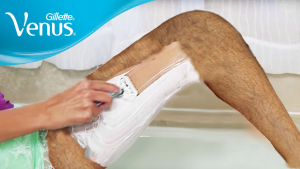
In this Gillette Venus advertisement, and in nearly every advertisement for female shaving products, there is an image of a pretty, white woman taking a bath, often immersed in a cloud of bubbles. With a “feminine” color-ed (i.e. pink or purple) razor in hand, she reaches out to shave … a flawless, silky smooth leg. Perhaps these women had forgotten they had already shaved their legs. Or perhaps, more likely, the companies are so disgusted by even a light dusting of hair on a lady’s legs that they would avoid all hint of having hair in an advertisement.
Beauty and personal hygiene advertisements thrive on reminding consumers of their body’s many supposed flaws. Thus, leg hair being removed in an advertisement supposedly depicting the product’s effectiveness as a razor in removing leg hair suggests that leg hair is too grotesque for audiences, reinforcing that there is no reason women should keep any unwanted hair. This also feeds into the standard of the impossible body type that women are held to.
Furthermore, these advertisements insinuate that if women don’t shave, they will lose their identity as a woman, therefore policing femininity. Gender stereotypes are also reinforced by suggesting that men and women are inherently different, and thus requiring separate products, such as men’s grey razors versus women’s pink razors. Also, advertisements for male shaving products do not shy away from showing a hairy model to advertise their product.
This advrtisement sells on using sexy to sell. This is common in many advertisements, but is especially prominent in commercials for female shaving products, which objectifies women. In this ad, this can be seen as the model is hyper-sexualized, as her face is cut off and the focus is on her specific body parts. This ultimately dehumanizes the woman in the ad, and encourages consumers to view her solely as a sex object, rather than a human.

It is baffling that advertisements for female shaving products do not use models with any hair. It is especially perplexing when you consider how many marketers and advertisements have limitless before-and-after comparison shots, such as in anti-aging or wrinkle creams, acne washes, weight loss programs, toothpastes, etc. It is common for marketers to use society’s version of natural ugliness, and then advertise their product which is aimed to make one more “beautiful.” However, unlike most commercials that show you how well the product works, commercials for female shaving products already show hairless, smooth legs.
Showing the female body without any body hair in these advertisements is done to hold a standard of femininity, and abide by the unwritten societal rules that women must never have hair on their arms, legs, underarms, or face. This advertisement was done to not shy away from showing women body hair.
Advertisements for male shaving products use models that have body and facial hair, and male razors are often grey or black. This contrast with advertisements for female shaving products, often done so by the same company, such as Gillette, further perpetuates gender stereotypes.
I attempted to create an ad that does not play into gender stereotypes by adding leg hair to the model and have her using a grey razor. I do this in an attempt for women to take charge and claim ownership of our bodies, allowing us to have the choice of shaving or not, which areas of our bodies we choose to shave, and finally how we will allow their products to be advertised to us. The altered ad may not seem sexually appealing to society’s standards, which is why the original advertisement has been successful. However, the original advertisement’s success is based on policing femininity, depicting what it means to be beautiful, objectifying women, and perpetuating gender stereotypes.
References:
Bernazzani, S. (2017). Women Shave Because of Marketers: How the Industry Created Demand for Women’s Razors. Blog.hubspot.com. Retrieved 1 July 2017, from https://blog.hubspot.com/marketing/womens-razors-marketing
Komar, M. (2017). 100 Years Of Shaving Ads Show How We’ve Been Tricked Into Going Hairless — PHOTOS. Bustle.com. Retrieved 1 July 2017, from https://www.bustle.com/articles/137072-100-years-of-shaving-ads-show-how-weve-been-tricked-into-going-hairless-photos
The Problem With Women’s Shaving Ads. (2017). Odyssey. Retrieved 1 July 2017, from https://www.theodysseyonline.com/the-problem-with-womens-shaving-advertisements
Veet ads spark outrage for implying women are manly if they don’t wax. (2017). Mail Online. Retrieved 1 July 2017, from http://www.dailymail.co.uk/femail/article-2599858/Sexist-new-Veet-ads-spark-outrage-suggesting-women-manly-dont-wax-body-hair.html
Video reveals how ads made women start shaving their armpits. (2017). Mail Online. Retrieved 1 July 2017, from http://www.dailymail.co.uk/femail/article-3320902/Video-reveals-sexist-ads-urged-women-start-shaving-armpits-time-1915-immaculate-unembarrassed-sleeveless-trends.html
Why Are Women In Razor Ads Always Shaving Hairless Legs?. (2017). HuffPost Canada. Retrieved 1 July 2017, from http://www.huffingtonpost.ca/entry/hairless-razor-commercials-are-silly_us_55a54966e4b0ecec71bd1f9b